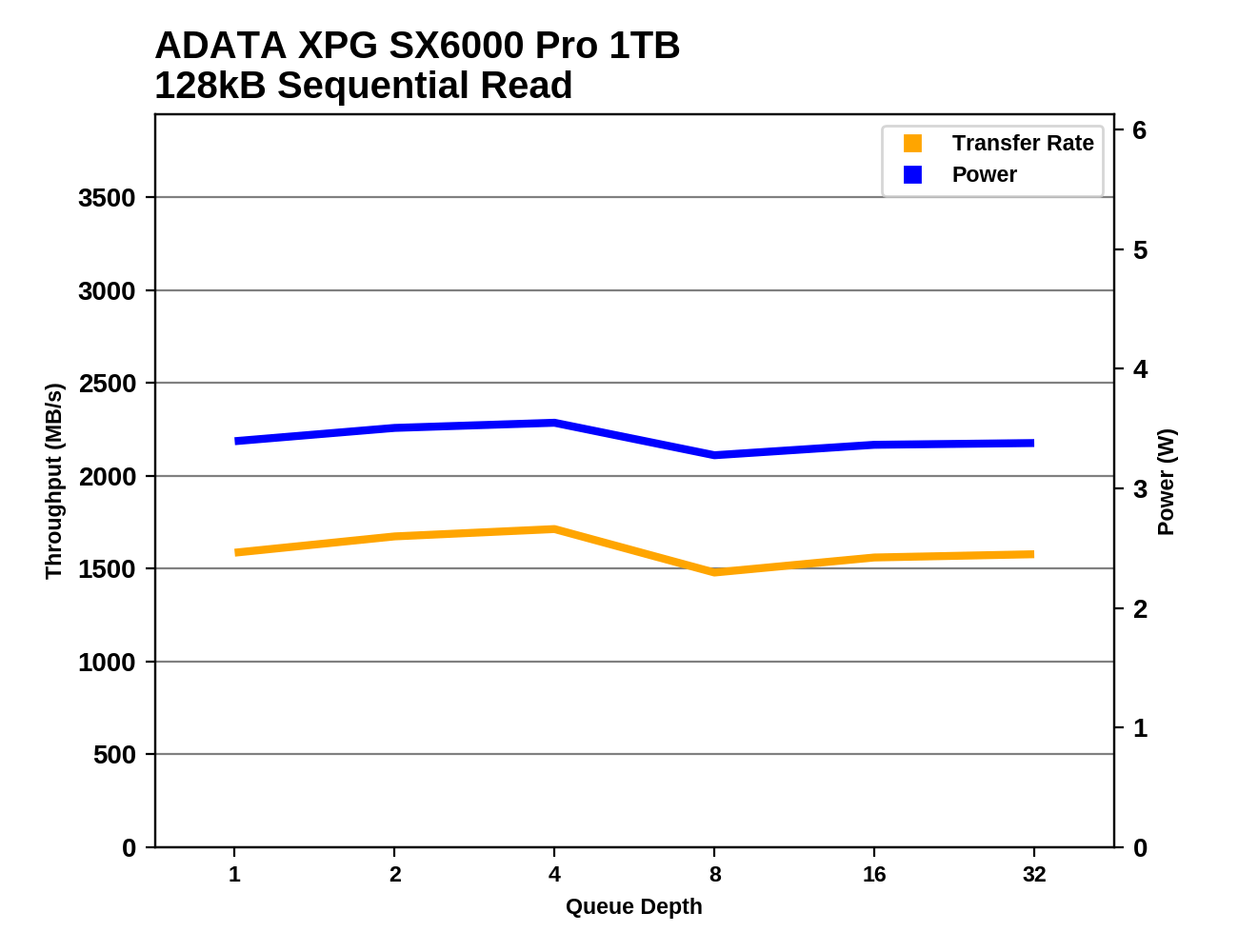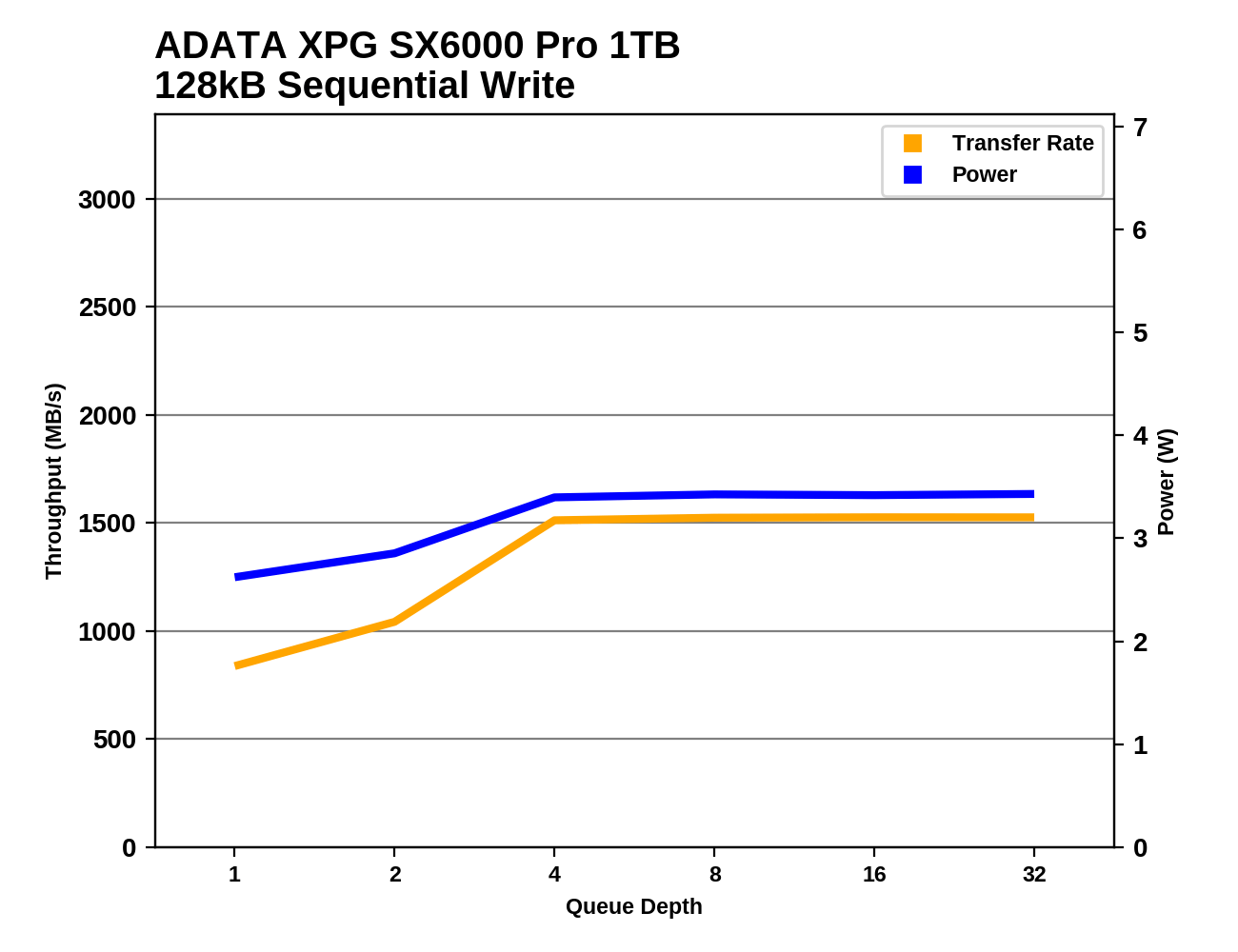The ADATA XPG SX6000 Pro 1TB SSD Review: Realtek's Entry-level NVMe Solution
by Billy Tallis on December 18, 2019 12:30 PM ESTSequential Read Performance
Our first test of sequential read performance uses short bursts of 128MB, issued as 128kB operations with no queuing. The test averages performance across eight bursts for a total of 1GB of data transferred from a drive containing 16GB of data. Between each burst the drive is given enough idle time to keep the overall duty cycle at 20%.

The burst sequential read performance of the ADATA XPG SX6000 Pro is comparable to other entry-level NVMe drives and some of the underperforming high-end drives. It is about three times the performance of SATA SSDs, and just over half the performance of the fastest high-end drives in this batch.
Our test of sustained sequential reads uses queue depths from 1 to 32, with the performance and power scores computed as the average of QD1, QD2 and QD4. Each queue depth is tested for up to one minute or 32GB transferred, from a drive containing 64GB of data. This test is run twice: once with the drive prepared by sequentially writing the test data, and again after the random write test has mixed things up, causing fragmentation inside the SSD that isn't visible to the OS. These two scores represent the two extremes of how the drive would perform under real-world usage, where wear leveling and modifications to some existing data will create some internal fragmentation that degrades performance, but usually not to the extent shown here.

On the longer sequential read test, the SX6000 Pro maintains its good standing. It's not in the top tier of high-end drives, but it is in the second tier that includes some high-end 8-channel+DRAM drives.
 |
|||||||||
| Power Efficiency in MB/s/W | Average Power in W | ||||||||
As usual, the power efficiency of the SX6000 Pro is poor, but for sequential reads it isn't the worst-scoring NVMe drive and it isn't too far below average.
 |
|||||||||
The sequential read performance of the SX6000 Pro dipped at QD8 and didn't fully recover before the end of the test, so even at high queue depths it doesn't attain the rated 2.1GB/s and instead is stuck closer to 1.5GB/s. The Mushkin Helix-L also showed a slight performance dip during the second half of the test, but it recovered and had no further trouble maintaining full speed.
Graphed against the whole database of results, the SX6000's power efficiency seems fairly middle of the road. The performance could have been achieved with a PCIe 3 x2 connection, but that's still pretty much par for entry level NVMe drives.
Sequential Write Performance
Our test of sequential write burst performance is structured identically to the sequential read burst performance test save for the direction of the data transfer. Each burst writes 128MB as 128kB operations issued at QD1, for a total of 1GB of data written to a drive containing 16GB of data.

The SX6000 Pro is by far the slowest NVMe drive on the burst sequential write test, only managing 1GB/s compared to 1.6GB/s or more for other entry-level NVMe drives.
Our test of sustained sequential writes is structured identically to our sustained sequential read test, save for the direction of the data transfers. Queue depths range from 1 to 32 and each queue depth is tested for up to one minute or 32GB, followed by up to one minute of idle time for the drive to cool off and perform garbage collection. The test is confined to a 64GB span of the drive.

On the longer sequential write test that also includes some higher queue depths, the SX6000 Pro's score improves slightly, while the other low-end NVMe drives slow down a bit due to the higher volume of writes in this test. There's still a substantial gap between the SX6000 Pro and the rest of the NVMe drives, but it's much smaller than the SX6000 Pro's lead over SATA SSDs.
 |
|||||||||
| Power Efficiency in MB/s/W | Average Power in W | ||||||||
The SX6000 Pro is tied for worst power efficiency among these NVMe SSDs, but it's still providing twice the performance per Watt of a SATA drive. The other two DRAMless NVMe drives take the top two spots for power efficiency on this test.
 |
|||||||||
The SX6000 Pro doesn't hit its full sequential write speed until QD4, while the Mushkin Helix-L and Toshiba BG4 both saturate at QD2, and the BG4 has a clear speed advantage at full speed. The ADATA SU750 didn't manage to reach full speed until QD8, so clearly Realtek's NVMe controller has some advantages over their SATA controller.
As with sequential reads, the power efficiency of the SX6000 Pro doesn't look too bad when graphed against our entire library of SSDs, but there's definitely room for improvement. At high enough queue depths, the performance gets up to near the same levels that most entry-level or outdated high-end NVMe drives offer, and the drives that are substantially faster are mostly high-end models from the past one or two generations.












36 Comments
View All Comments
Samus - Wednesday, December 18, 2019 - link
I don’t think you are being critical enough of this drive. It is appallingly bad. It’s basically outclassed by SATA drives from years ago in almost every metric except sequential performance (where NVMe will naturally excel)But real world performance is terrible, power usage is high (and it has broken devsleep) and it isn’t very cheap. When you consider reliability is a total u known I’m struggling to imagine a single person who would consider this.
Billy Tallis - Wednesday, December 18, 2019 - link
Let me make it a bit clearer for you: https://www.anandtech.com/bench/product/2533?vs=22...The MX500 beats the SX6000 Pro on just ONE of those performance metrics. The picture's not that different if you compare against a Samsung SATA drive. Overall performance is clearly much better than a SATA SSD. It's not appallingly bad. It just isn't a high-end NVMe drive.
DPUser - Wednesday, December 18, 2019 - link
Appallingly Clearer. : )Alistair - Wednesday, December 18, 2019 - link
haha nice :)JoeyJoJo123 - Wednesday, December 18, 2019 - link
Based Billy Tallis *dabbing* on the n00bs in the comments section. FACTS don't care about your feelings, Samus. It's times like this I'm glad you can't edit your comments, since moments like these are eternalized forever.MFinn3333 - Wednesday, December 18, 2019 - link
To be fair, the Samsung 850 Pro does beat it in the sustained random read/writes, power efficiency of said read/writes and uses a lot less power while active idle.https://www.anandtech.com/bench/product/2310?vs=25...
(Blue is Samsung and Orange is ADATA because Samsung is blue in my mind).
To be fairer, the Samsung is at least five years old, costs three times as much if you can get it, and has an idle response that is 15X worse than the ADATA. The ADATA is clearly the better drive for 99% of the population.
The_Assimilator - Wednesday, December 18, 2019 - link
It's absolutely appallingly bad. You can't simply excuse broken power management with "the other vendors messed it up too", the point is that none of those other vendors have messed it up NOW. Realtek failed to learn from and avoid their competitors' mistake, and by doing so have introduced their controller with a handicap versus the same competitors. It's also both unproven, slower, and more expensive than older controllers that do have a known track record, so that's four strikes against the RTS5763DL.In contrast, drives using the two-year-old SM2263XT are faster, cheaper, and to be blunt, just better. There is thus no reason why anybody would ever choose a drive using RTS5763DL, and its complete failure to compete is only going to become more apparent once the next-gen SMI and Phison controllers arrive (and E12 products go EOL and get huge discounts).
In short, while not as bad as Realtek's attempt at a SATA SSD controller, the RTS5763DL is just a plain bad product that simply cannot be recommended in any way shape or form.
milli - Wednesday, December 18, 2019 - link
Well look at this one again then: https://images.anandtech.com/graphs/graph15139/sus...I've learned from real-life usage that this test is one of the most important metrics that you will notice in your day to day usage. The Realtek is by far the fastest cacheless NVMe controller out there in this test.
Also while the drive lacks DEVSLP, statements like "broken power management" are just false. The graphs clearly show that it cuts power in half in each state. Lacking DEVSLP does not equal broken power management. ADATA even clearly states this on their website.
gregassagraf - Wednesday, July 21, 2021 - link
well... I installed the xpg Gammix s41 which is based in the same microcontroller! I lost more than an hour of battery life in my laptop and now sleep mode is basically useless. One big mistake in my part was caring only about read and write speeds. I can't wait to replace this drive, its driving me mad!mark625 - Wednesday, December 18, 2019 - link
The HP EX950 1TB has been my favorite value/$ drive for a while, and it costs a whole $7 more than the SX6000 Pro. It whomps the XPG drive in almost every test, and in many tests it is more than twice as fast.In what possible scenario would the XPG drive be a smarter purchase than the HP? None that I can see. This review is way too forgiving.